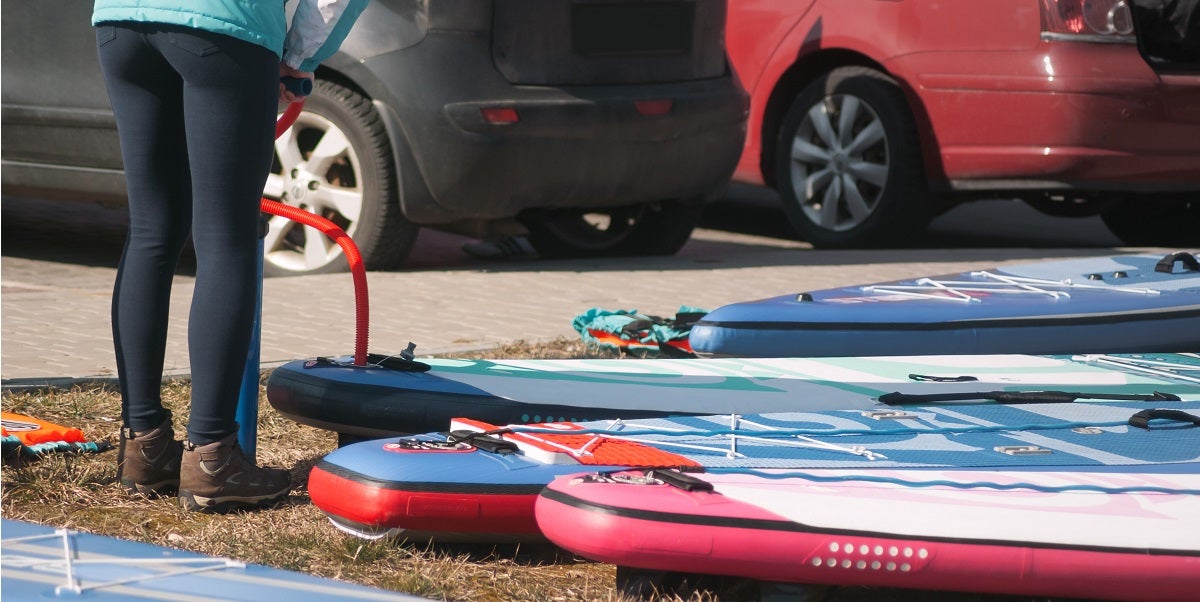
Our Editors independently research, test, and rate what we feel are the best products. We use affiliate links and may receive a small commission on purchases.
Paddle boarding is one of the best times you can have when the water is nice. If you have an inflatable paddle board then you know how convenient it is. There is no need to worry about where to put it or hassle with tying it up to your vehicle whenever you head out to the water.
While overall inflatable boards are more durable than rigid paddle boards, you do run the risk of it getting a rip or leak in it. Not to worry if that happens to you, though, as we have the best tips of how to repair and patch your inflatable paddle board.
How Do Leaks Happen?
One of the most common causes of leaks is simply use and age. However, these can also happen with things like bumping against rocks that lie under the water, against trees as you’re heading down to the lake or beach, and so on. The good news is that most high-quality brands will provide you with a repair kit as well.
1. Tools
You’re obviously going to need some tools to get the job done. If you still have your repair kit that came with your board, that’s perfect! It should contain patches, brushes, glue, and a tool pen. You’ll need to also grab some scissors to cut the patch to the right size for the leak in question, along with a cloth to clean the surface of your board. Once you have that, you’re ready to begin patching it all up!
2. Cleaning Over Where the Leak Is
That’s what your cloth is for! Make sure to locate it so you have absolutely no doubt where it is. You don’t need anything fancy – just some soap and water will do. If you’re unsure of where the leak is, try inflating your board a bit, then putting some soapy water around where you suspect the leak is located. You’ll find bubbles appear at the leak. Another way of doing this is simply listening for the sound of water escaping.
3. Prepare Your Patch
After it’s nice and clean, you’ll need to take one of the patches in your repair kit out. You may have different-colored patches depending on the color scheme of your SUP, so make sure yours matches according to where it’s located.
Next, take your scissors to cut a size large enough to fully cover the leak without worry. We recommend making it at least three inches around the hole in all directions. Try not to rush this part as you don’t want to accidentally cut it too small. After it’s cut, use your cloth to clean it one more time.
4. Apply the Glue
Once you’ve cut the patch to your liking, it’s time to apply the glue. Take the brush that you have in your repair kit, put a bit of glue on it, and gently apply it to the patch as well as the exterior of your board, where you want to stick the patch over. Try starting in the middle of the patch and working your way out to the edges. Just make sure that you have applied enough that it will firmly stay on so you don’t end up with a leak again.
5. Apply and Seal the Patch
Now that you’ve put enough glue onto the patch and surface of your SUP, press it firmly onto your board to get rid of any bumps, ridges, and general uneven spots. Once you have it stuck on nice and solid, clean off the whole space and get rid of any glue remnants you may have. If you really need to get the glue off and it won’t budge, get out the acetone.
6. Enjoy!
That’s literally all there is to it! Wasn’t that easy? It only took a couple of minutes and now you’ll be prepared if you happen to run into another hole that needs patching up. You’re almost ready to get out and go paddle boarding, but we first recommend waiting at least 24 hours before doing so. If you have a plan to go out with friends within that time period, hopefully you’re able to rent a board for the time being. Just make sure the glue has completely dried before using it again.
Extra Note
If you have a board with PVC or urethane-coated material, there are also some excellent urethane adhesives out there that can be used to apply a patch with. As occasional damage comes in the form of a coating abrasion, you’ll simply paint on a layer of said adhesive. As it’s not a puncture, a patch isn’t really necessary.
